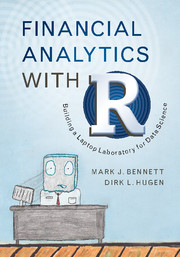Book contents
- Frontmatter
- Dedication
- Contents
- Preface
- Acknowledgments
- 1 Analytical Thinking
- 2 The R Language for Statistical Computing
- 3 Financial Statistics
- 4 Financial Securities
- 5 Dataset Analytics and Risk Measurement
- 6 Time Series Analysis
- 7 The Sharpe Ratio
- 8 Markowitz Mean-Variance Optimization
- 9 Cluster Analysis
- 10 Gauging the Market Sentiment
- 11 Simulating Trading Strategies
- 12 Data Exploration Using Fundamentals
- 13 Prediction Using Fundamentals
- 14 Binomial Model for Options
- 15 Black–Scholes Model and Option-Implied Volatility
- Appendix Probability Distributions and Statistical Analysis
- References
- Index
Preface
Published online by Cambridge University Press: 20 October 2016
- Frontmatter
- Dedication
- Contents
- Preface
- Acknowledgments
- 1 Analytical Thinking
- 2 The R Language for Statistical Computing
- 3 Financial Statistics
- 4 Financial Securities
- 5 Dataset Analytics and Risk Measurement
- 6 Time Series Analysis
- 7 The Sharpe Ratio
- 8 Markowitz Mean-Variance Optimization
- 9 Cluster Analysis
- 10 Gauging the Market Sentiment
- 11 Simulating Trading Strategies
- 12 Data Exploration Using Fundamentals
- 13 Prediction Using Fundamentals
- 14 Binomial Model for Options
- 15 Black–Scholes Model and Option-Implied Volatility
- Appendix Probability Distributions and Statistical Analysis
- References
- Index
Summary
In 1994 the Channel Tunnel opened between England and France, allowing high-speed Eurostar trains to whisk passengers from the continent to the United Kingdom and back on a grand scale. What an amazing engineering feat it was for the time (beyond many people's earlier imaginations), yet we take it for granted today. In 1994, Grumman Aerospace Corporation, the chief contractor on the Apollo Lunar Module, was acquired by Northrop Corporation to form the new aerospace giant, Northrop Grumman. It was the prime contractor of the newly deployed advanced technology B-2 Stealth Bomber. On a much more mundane and personal scale, also in 1994, in a townhouse just outside the City of Chicago, I was performing a tedious daily exercise: looking up daily closing prices each evening in a stack of Investor's Business Daily newspapers for the two stock investments that were about to be purchased. This was not only to find out their running rate of return but also to find out their historical volatility relative to other stocks before entering into the positions. Doing this manual calculation was slow and tedious. The WorldWideWeb was introduced in the form of the Mosaic browser the next year. It was not long before Yahoo! was posting stock quotes and historical price charts, as well as technical indicators on the charts, available on demand for free in just a few seconds via the new web browsers.
The advent of spreadsheet software took analysts to a new level of analytical thinking. No longer were live, human-operated calculations limited to a single dimension. Each row or column could present a time dimension, a production category, a business scenario. And the automated dependency feature made revisions quite easy. Now spreadsheets can be used for a prototype for a more sophisticated and permanent analytical product: the large-scale, analytical computer program.
With modern programming languages like R and Python®, a skilled analyst can now design their analytic logic with significantly less effort than before, using resources such as Yahoo! or other free services for historical quotes. It has been said that Python's terse syntax allows for programs with the same functionality as their Java equivalents, yet four times smaller, and we suspect that R is similar. A small financial laboratory can be built on a laptop costing less than $200 in a matter of weeks, simulating multiple market variables as required.
- Type
- Chapter
- Information
- Financial Analytics with RBuilding a Laptop Laboratory for Data Science, pp. xiii - xviPublisher: Cambridge University PressPrint publication year: 2016



